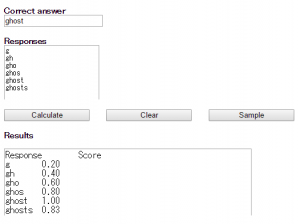英単語のスペリングを採点する際に、「おしいスペリングミスには部分点をあげたい」と思われる方は多いでしょう。しかし、何をもって「おしい」とするかには個人差があり、主観的な判断が入ってしまいがちです。
第二言語習得研究においても、”minor spelling mistakes(軽微なスペリングのミス)” (Laufer & Nation, 1999, pp. 38–39), “close approximations of the target word(模範解答に良く似た解答)” (Webb, 2009, p. 455), “misspelled responses which clearly resembled the correct answer(模範解答に明らかに似た誤答)” (Webb & Kagimoto, 2009, p. 64)といった、主観的な基準で部分点が与えられていることがあります。
そこで、スペリングに関する知識を客観的に評価するひとつの試みとして、スペリングミスの度合いに応じて部分点を自動で計算するwebアプリを開発・公開しました。
「EASS (Electronic Automated Spelling Scorer): It puts you to ease (with spelling)」
本ソフトウェアはJoe Barcroft教授 (Washington University in St. Louis, USA)によって開発された、 The lexical production scoring protocol (LPSP)を元にスコアを算出します。
LPSPの詳細については、以下をご参照ください。
Barcroft, J. (2002). Semantic and structural elaboration in L2 lexical acquisition. Language Learning, 52, 323–363.
Barcroft, J. (2003). Effects of questions about word meaning during L2 Spanish lexical learning. The Modern Language Journal, 87, 546–561.
Barcroft, J., & Rott, S. (2010). Partial word form learning in the written mode in L2 German and Spanish. Applied Linguistics, 31, 623–650.
使用方法
- 「EASS (Electronic Automated Spelling Scorer)」にアクセスします。
- 「Correct answer」と書かれたボックスに、模範解答を入力します。
- 「Responses」と書かれたボックスに、解答を入力します。解答は複数入力することができます。
- 「Calculate」ボタンを押すと、入力した解答全てに対して、スコアを計算することができます。
- 本ソフトウェアは無料で使用出来ます。
結果の見方
結果の見方は以下の通りです。
- Response:入力した解答です。
- Score:その解答に与えられるスコアです。
注意点
- 英語のアルファベット以外の文字(á, é, í, ó, or úなど)には対応していません。
- 句読点などの記号は無視されます。
- 大文字・小文字は異なる文字として認識されます。
- 本ソフトウェアを使用した事により生じるいかなる損害に関しても、開発者は責任を負いません。
References
Laufer, B., & Nation, I. S. P. (1999). A vocabulary size test of controlled productive ability. Language Testing, 16, 36–55.
Webb, S. A. (2009). The effects of pre-learning vocabulary on reading comprehension and writing. Canadian Modern Language Review, 65, 441–470.
Webb, S. A., & Kagimoto, E. (2009). The effects of vocabulary learning on collocation and meaning. TESOL Quarterly, 43, 55–77.

